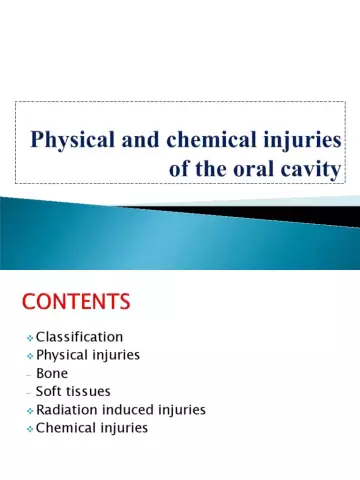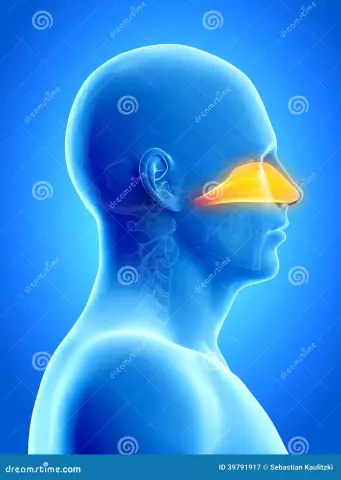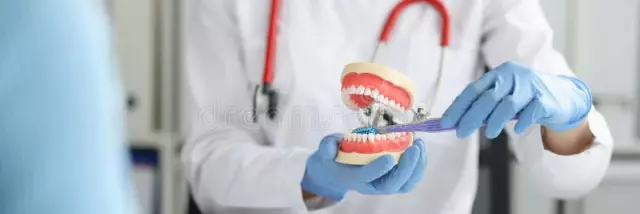- Author Rachel Wainwright [email protected].
- Public 2023-12-15 07:39.
- Last modified 2025-11-02 20:14.
Oral cavity

The digestive tract begins with the oral cavity. This is not only its anatomical beginning - the digestion of food begins already in the oral cavity. In addition, the oral cavity has a number of additional functions not related to digestion.
The structure of the oral cavity
Its borders are the mouth gap in front and the pharynx in the back. The mouth gap, in turn, is limited by the upper and lower lips.
The oral cavity is conventionally divided into two sections. The front section - the vestibule of the mouth - is bounded by the lips and cheeks in the front and the teeth and jaws in the back. The vestibule is shaped like a horseshoe. The posterior section - the oral cavity itself - is bounded from the front and sides by the teeth and jaws, and from the back by the opening of the throat, which is the beginning of the pharynx. Above, the border of the oral cavity is a hard and partially soft palate, below - the muscular frame, which is called the floor of the oral cavity.
The soft palate ends with a palatine tongue, which takes part in the formation of the voice, and hangs down in a calm state. The mucous membrane of the oral cavity, passing down from the soft palate, forms the palatine arches on the sides of the uvula - between which there are accumulations of lymphoid tissue - the palatine tonsils.
In the oral cavity, the tongue is central. From it to the bottom of the oral cavity there is a bridle - a fold of the oral mucosa. On the sides of the bridle, you can see the outlet openings of the ducts of the salivary glands.
Oral functions
The digestive process begins in the mouth - the food is crushed by the teeth, moistened with saliva with the formation of a food lump, warmed or cooled to the desired temperature.
Saliva has a number of important functions:
- Enzymatic breakdown of carbohydrates;
- Cleansing the oral cavity from food debris, neutralizing acids formed after eating and protecting teeth from caries;
- Specific and non-specific immune protection;
- Contains biologically active substances that regulate metabolism;
- Participates in the formation of sounds.
The oral cavity takes part in breathing, speech formation and articulation.
The tonsils play an important role in the body's immune defense against infections. They are part of the so-called "lymphopharyngeal ring", which is a protective "gate" at the border of the airways.
Microorganisms are always present in the mouth - permanent and unstable. Their number changes regularly, and largely depends on oral hygiene. The permanent microflora is represented mainly by anaerobic bacteria and fungi, which can live without air. By binding to receptors on the surface of the epithelium, they play the role of a biological barrier, since they do not allow pathogenic microbes to multiply. In addition, its own microflora promotes self-cleaning of the oral cavity, and all the time stimulates local immunity. Changes in the composition of microflora can lead to the occurrence of diseases of the oral cavity.
Methods for examining the oral cavity
Revealing pathology begins with asking a person about his complaints. Most often, with diseases of the oral cavity, people complain of pain and disorders when eating, talking, swallowing. For example, when a person complains of a persistent dry mouth, it could be a sign of decreased function of the salivary glands. Bad breath is a sign of periodontitis, tooth decay, or gingivitis. Diction defects can be facilitated by an incorrectly selected denture, a cleft palate.
During the examination, the relief of the mucous membrane, its color, the presence of erosions and ulcers, dental prints on the tongue, and the health of the teeth themselves are assessed.
To identify diseases accompanied by excessive keratinization of the mucous membrane, it is irradiated with fluorescent rays of a Wood lamp. Sometimes a bacteriological, cytological, immunological examination or an allergy test is required. A clinical blood test for diseases of the oral cavity is the minimum required diagnostic test.
Diseases of the oral cavity

The oral cavity is affected by a variety of diseases. Congenital malformations are formed in utero, and are mainly represented by:
- Cleft upper lip (unilateral or bilateral);
- Cleft lower lip;
- A cleft of the hard palate;
- Lack of lips (acheilia);
- Fusion of the lips on the sides (sinheilia).
Treatment of the oral cavity with such defects is surgical. The thickened and shortened frenum of the tongue is referred to as the stigma of dysembryogenesis.
The group of diseases of the oral mucosa is very extensive - these are infectious, allergic, and tumor processes. Inflammatory processes in the oral mucosa are called stomatitis. The health of the whole organism is reflected in the condition of the oral mucosa.
Caries is a damage to the tooth tissues caused by a violation of the acidity of the oral cavity and the activation of its microorganisms. Violations of oral hygiene and hereditary factors that determine the stability of tooth tissues in an aggressive environment play a role in its occurrence. Treatment of the oral cavity with caries and other dental diseases is the task of the dentist.
When, as a result of a decrease in local or general immunity in the mouth, fungi of the genus Candida, which are always present there, actively multiply, candidiasis of the oral cavity develops. This pathological process in the oral cavity is most often found in newborns, the elderly and HIV-infected people. It manifests itself as unpleasant painful sensations, a burning sensation, and on the affected surface you can see a white cheesy bloom, under which, after removing the plaque, bright red erosion is exposed. In most cases, oral candidiasis is effectively treated with topical antifungal agents in the form of solutions or sprays. The appointment of antifungal drugs by mouth in capsules and tablets is required only with severe immunodeficiency.
Trauma and mechanical damage to the oral cavity heal quickly due to the high regenerative capacity of the mucous membrane.
Found a mistake in the text? Select it and press Ctrl + Enter.






